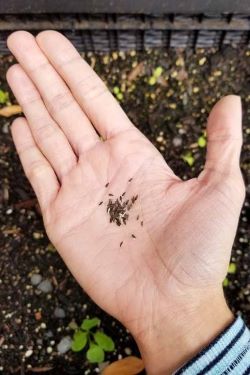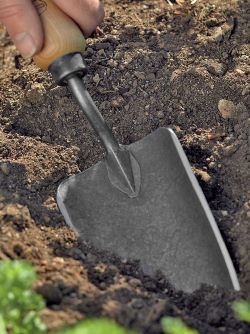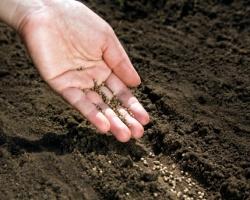Planting Cool Weather Vegetables

April is the time to plant cool weather vegetable seeds.
Some vegetables like to grow in cool weather. They germinate and grow quickly. You can have a crop in 45 to 60 days!
Common cool weather vegetables you can plant directly in the soil in April are:
Arugula, Beets, Collards, Carrots, Chard, Kale, Lettuce,
Microgreens, onions (bulbing and bunching), peas, radishes, and spinach. There are still seed packets for sale in many stores.
What do you need?
- Seeds
- garden bed with soil and compost
- trowel
- source of water
- plant marker
Let's get started!
1. Preparing your garden bed:
By now your garden bed is prepared. If not see the tutorial on raised or trug garden beds. Lettuce and radishes are ideal for the
beginner. They take up very little space and can be planted in a raised bed, trug, or a container with ease.
Optimal soil pH is between 5.8 and 6.5 for most cool weather vegetables. If your garden bed is new with new soil and compost, you have little
to worry about soil pH (acidity). However, if you are using an existing garden bed with existing soil, a soil test is always recommended.
UCONN is still offering soil tests through the mail.
 2. Gathering your tools:
2. Gathering your tools:
You already used a hoe and rake to prepare the soil. Now, all you need is a trowel to create a furrow where you want your lettuce seeds
to be planted.
3. Follow instructions on the seed packet:
Read the instructions on the back of the seed packet to determine how deep your furrow should be. Some seeds need light to germinate
and are only pressed into the top of the soil. Most seeds need a furrow about 1/4 inch deep.
4. Sprinkle seeds into the furrow:
Tiny seeds are a bit challenging to separate as you plant them in the furrow. Serious gardeners will buy a precision
seed dispenser. They are not expensive. It is wise to try your best to plant seeds with at least 1/2 inch space between to avoid the
unappealing task of thinning seedlings later.
Vegetables that are too crowded will not grow well.

5. Cover your seeds:
Use the trowel to gently pull soil back into the furrow to cover the seeds. Gently press the soil down with your hands or the back
of the trowel to hold the seeds in place during rain storms.
6. Mark your seeds:
Even if you have written a garden diagram, it is still a good idea to mark your furrows with a plant marker to identify the vegetable
you planted there. Easy plant markers are plastic knives. You can use a permanent marker to write the name of the vegetable and its variety on the handle
and simply push the serrated half into the ground.
7. Water your seeds:
Seeds must be kept constantly moist! Water your furrow every day. If a seed dries out it will not sprout.
This will be your most crucial gardening task. Once sprouted, you can water less frequently to avoid drowning the plant.
8. Sprouted seedlings:
Once your seeds sprout you will see how many seeds successfully germinated. It is okay if the row is not perfectly straight as long as each
plant has room to grow. See the Maintaining Your Garden Tutorial to keep your plants growing!

2. Gathering your tools:
